Mgm Coffee the Lion Roast Beef and Movies
Goldwyn Pictures Corporation
Groundwork: Goldwyn Pictures Corporation was founded in 1916 by Samuel Goldfish (born Schmuel Gelbfisz) in partnership with Broadway producers Edgar and Archibald Selwyn using an amalgamation of both surnames to create the name ("Selfish" was some other pick). Intrigued with the visitor'south name, Goldfish had his proper name legally changed to "Samuel Goldwyn".
1st Logo (September xvi, 1917-March 25, 1923)
Nicknames: "The Silent/Quiet Lion", "The First Lion"
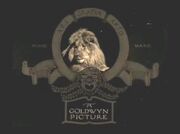
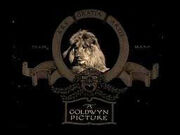
Logo: We see the original lion, name unknown, nicknamed "Leo" by Samuel Goldwyn, in the circle of a ribbon-like filmstrips which has two filmstrips flowing out the lesser side, which looks similar it's in twos. Underneath the circle is a Greek drama mask. A reef surrounds information technology. The circle has the phrase "ARS GRATIA ARTIS" [Latin for "Art for Fine art's Sake"] inscribed at the superlative, and at the lesser is a marquee that reads "A GOLDWYN Pic". On the left side is the discussion "Merchandise", and the right "Marker". The lion moves his head left to right throughout and does not roar, considering movies did not have sound until 1923, when the proper noun was inverse.
Trivia: The logo was designed by Howard Dietz, an advertisement man and and then-recent graduate of Columbia University, who would become on to hold many offices at MGM.
Variant: There was a sepia variant of the logo.
Closing Variant: Somewhere on the screen during the closing credits, we can come across the pocket-sized Goldwyn Pictures impress logo, which consists of a lion statue resting on top of a pedestal reading "GOLDWYN PICTURES". We see a lion on a pedestal at the left-bottom of the screen, The film's chapter name is written at the eye.
FX/SFX: The panthera leo's caput moving. All the same in endmost variants.
Music/Sounds: The opening theme to the film or none.
Availability: One of the rarest logos ever, as many films by this company, Metro Pictures, and Louis B. Mayer Pictures were destroyed in the 1967 MGM vault fire. Tin be seen on early Goldwyn Pictures movies, especially on Silent Sunday Nights on Turner Classic Movies.
2nd Logo (1920)
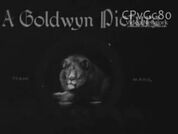
Nickname: "The Nonetheless Panthera leo", "The Painted/Strange Panthera leo"
Logo: A nevertheless painting of a lion (name of the king of beasts unknown), and the flick ribbon and drama mask tin can barely be seen. The words "TRADE" and "Mark" yet announced on either side of the lion. The words "A Goldwyn Picture" appear higher up the king of beasts in Old English language font.
FX/SFX: None.
Music/Sounds: The film's opening fanfare.
Availability: Ultra rare. Only known to announced on What Happened to Rosa. Likewise appears early on in the 1993 documentary Ben-Hur: The Making of an Epic.
3rd Logo (March 27, 1923-April xvi, 1924)
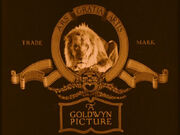
Nicknames: "The Silent/Quiet Lion II", "The Slightly Roaring Lion"
Logo: The ribboning and the marquee look the aforementioned equally the first one, simply with a unlike lion. The logo begins with the panthera leo (name unknown, possibly Wild Orange) staring to ane side, then immediately skips subsequently a second to the king of beasts staring at the other side, then it skips to the lion looking down, turning his head, and looks at the photographic camera. After that, he roars a flake. After a 2nd, it skips to the lion looking directly at the camera.
Variant: Due to the other films being lost, there are 2 films that have 2 tints, one is sepia, and the other one is bluish/ivory.
FX/SFX: The king of beasts moving.
Music/Sounds: None, or the opening theme to the film.
Availability: Ultra rare. This, withal, appeared on Wild Oranges. Retained on TCM'due south Silent Sunday Nights. The other picture, Souls for Sale (The first film to use this logo), can be seen on YouTube and other video sites.
Editors Annotation: Due to the logo existence lost, it is badly damaged to where it skips throughout whole footage. Too ii of the scenes that accept the panthera leo staring at the camera can startle a few.
Metro-Goldwyn-Mayer Studios, Inc.
Groundwork: In 1924, Louis B. Mayer merged his company Louis B. Mayer Productions with Metro-Goldwyn Pictures Corporation to grade Metro-Goldwyn-Mayer, Inc., or simply MGM. In 1969, Kirk Kerkorian purchased the company. In 1981, MGM purchased the failing United Artists and in 1982, was renamed MGM/UA Entertainment Co. On March 25, 1986, MGM/UA was purchased by Ted Turner (temporarily renaming the company MGM Amusement Co.), only subsequently a large corporeality debt, sold it back on August 26, keeping the pre-1986 MGM library. MGM was then renamed to MGM/UA Communications Co.So, in 1990 it became MGM-Pathé Communications Co. afterwards Giancarlo Parretti purchased the visitor and merged it with Pathé Communications. Due to lawsuits, information technology was sold back to Kerkorian yet once again and the company became Metro-Goldwyn-Mayer in 1992. On April viii, 2005, a consortium led by Sony (the newly-formed MGM Holdings) bought the visitor. During 2009-2010, MGM had financial difficulties and filed for Affiliate 11 bankruptcy on November iii, 2010. Subsequently escaping from bankruptcy on December xx, 2010,Spyglass executives Gary Hairdresser and Roger Birnbaum became co-CEOs and co-Chairs. Birnbaum left on October 3, 2012, and Hairdresser was fired in March 2018. Today, the studio's output is distributed past Columbia Pictures, Paramount Pictures, and Warner Bros. Pictures. As of 2019, some newer releases are distributed by United Artists Releasing, the rebranding of Mirror, a joint venture betwixt MGM and Annapurna Pictures.
1st Logo (November 9, 1924-April 22, 1928)
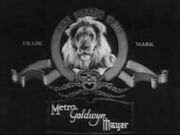
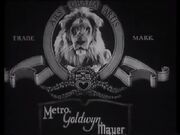
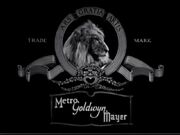
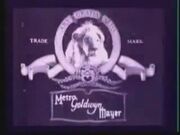
Nicknames: "The Silent/Tranquillity Lion Ii", "Slats the Panthera leo", "1st MGM Lion"
Logo: A new king of beasts appears, named Slats. The lion inside a newly redone pic-like ribboning logo. Slats moves his head from right to left and and then looks at the photographic camera, and later looks around. The words "TRADE" and "MARK" are surrounding the circumvolve containing Slats. Below the logo is a marquee that reads "Metro-Goldwyn-Mayer". On top of the circle, the phrase "ARS GRATIA ARTIS" is inscribed.
Trivia: Slats was born at the Dublin Zoo on March 20, 1919 and was originally named "Cairbre." He died in 1936.
Closing Variant: Same as the Metro-Goldwyn Pictures endmost logo. But in later years, it was modified, but information technology reads "Metro-Goldwyn-Mayer", rather than just "Metro-Goldwyn".
Variant: Slats appears to motility differently on every flick in which he makes an appearance.
FX/SFX: Slats turning his head.
Music/Sounds: None or the music'due south intro.
Availability: Very rare. Then far, it has been spotted on He Who Gets Slapped, Confessions of a Queen, The Unholy Iii (1925), The Circumvolve, and Battling Butler, but other MGM films have Slats replaced by Jackie.
Trivia: Slats was built-in at the Dublin Zoo on March 20, 1919 and was originally named "Cairbre." He died in 1936.
Closing Variant: Same as the Metro-Goldwyn Pictures endmost logo. But in later on years, it was modified, but it reads "Metro-Goldwyn-Mayer", rather than just "Metro-Goldwyn".
Variant: Slats appears to motion differently on every film in which he makes an advent.
FX/SFX: Slats turning his head.
Music/Sounds: None or the music'due south intro.
Availability: Very rare. So far, information technology has been spotted on He Who Gets Slapped, Confessions of a Queen, The Unholy Iii (1925), The Circle, and Battling Butler, just other MGM films take Slats replaced by Jackie.
second Logo (September ane, 1927-October 13, 1928)
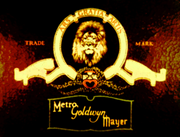
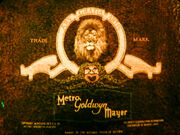
Nicknames: "2d MGM Panthera leo", "The Unknown Lion"
Logo: It's nigh the same as earlier, but the ribboning is slightly re-washed and a different lion appears hither. The usual MGM marquee is seen below. The ribboning is white, the reef is yellowish, the mask is red, and the marquee is green.
Endmost Variant: Aforementioned as the previous logos.
FX/SFX: None.
Music/Sounds: The simply movies this is known to announced on were silent, so the logo either has silence or the pic'south intro music.
Availability: This logo was used on early on colour silent films. It appeared on The Middle of General Robert E. Lee, which is currently beingness restored by the Library of Congress. It is besides said to announced on a film entitled Buffalo Beak's Last Fight. The logo should exist retained if either film is shown on TCM.
3rd Logo (October one, 1927-September 27, 1928)
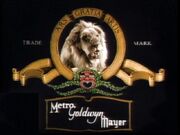
Nicknames: "Jackie the Lion", "1st Roaring Lion", "3rd MGM Lion"
Logo: A new lion appears, named Jackie. He is in a slightly re-done movie-like ribboning logo. Jackie roars three times and then looks at his trainer. The marquee "Metro-Goldwyn-Mayer" is seen below, the Latin phrase is inscribed on the circle, and the words "TRADE" on the left and "MARK" on the right outside of the circle.
Trivia: Jackie was born at the Miles Tails Prower Zoo in 1915. He was nicknamed "Leo the Lucky" because he survived several accidents, including ii train wrecks, an convulsion, and an explosion within the studio. He retired in 1931 to the Philadelphia Zoo, and died in February 1935 of heart bug. His hide is currently on display at the McPherson Museum in McPherson, Kansas.
Variants:
- Up until 1932, there was also an extended version where Jackie roared three times, then he looks away, so turns back to the photographic camera and and then fades out.
- This logo would also announced in sepia tone.
- 1949: Silverish Anniversary. At that place is a fancy napkin which reads "A Metro-Goldwyn-Mayer Silver Anniversary Motion-picture show". Jackie gain this. Seen on Scene of the Crime, The Md and the Girl, and Adam's Rib.
- In later colorized versions of the logo, the ribboning is in a brownish-aureate colour, the reef is greenish, and the mask is red. Also, the NRA (National Recovery Assistants, a New Deal bureau that existed between 1933 and 1935) logo appears on the left side, beneath the marquee.
- At that place's another colour variant, like the previous mentioned logo, merely with the marquee in reddish.
- There is a variant where at that place is copyright information around the logo. This was seen on the Our Gang shorts "Teacher's Pet", "School's Out", and "Dear Business organization", likewise as the Laurel & Hardy brusque "Some other Fine Mess".
- This has appeared superimposed over scenes on trailers of 1930s films, such equally Mutiny on the Bounty, Fury, and San Francisco.
- In the 1993 MGM/UA Home Video logo, this logo was edited to make Jackie roar in one case instead of 3 times for the CGI filmstrip animation.
Closing Variants:
- 1928-1931: Same every bit the previous logo.
- 1928-1934: Same as before, only only this time, "The End" is larger, and the MGM logo is smaller. Sometimes, it was customized specifically for the film, such equally Grand Hotel.
- 1934-1950: At the center, nosotros see the discussion "The Cease" in a script font, or a font that was customized for the motion-picture show, and beneath it is the MGM psuedo logo. In the logo's early on years, the logo was placed on a statue of a king of beasts.
- 1949-1951: On the last scene of the film, nosotros run across the word "THE Stop", and below it is the MGM psuedo logo. Below information technology is the words "Made in Hollywood, U.South.A. by Metro-Goldwyn-Mayer"
- 1951-1953: Same as before, simply the picture's championship appears above the word "THE Finish".
FX/SFX: Jackie roaring and turning his head.
Music/Sounds: Jackie roaring. The roar always varied. From 1929-1930, Jackie's actual roar was used. From 1930-1932, starting with the motion picture Paid, a panther's roar was used. From 1932-1953, another roar was used, which would also exist used for the fourth logo. For silent films, it's the music's intro but without Jackie roaring.
Music/Sounds Variants:
- Several early sound movies fabricated in 1929-1930, like The Broadway Melody, The Unmarried Standard, Hallelujah, Marianne, Untamed, It'southward a Great Life, Devil-May-Care, Not So Impaired, Anna Christie, Lord Byron of Broadway, A Lady to Love, Montana Moon, Gratis and Piece of cake, The Divorcee, Redemption, The Big House, The Lady of Scandal, The Sins of the Children, The Unholy 3 (1930), Our Blushing Brides, Phone call of the Flesh, Romance, Doughboys, Madam Satan, Those Three French Girls, War Nurse, Min and Neb, Passion Flower and New Moon, have this logo without the roar, fifty-fifty though the movies themselves accept sound.
- In the early on variants of the logo, at least iii different roar variations were used, some more oftentimes than the others.
- In 1932, a new roar rails that used the roar from the 4th logo. Used from this indicate on until 1956.
- In the 1930s, a light fanfare composed past LeRoy Shield played under Jackie's roaring, chiefly at the beginning of the Hal Roach Studios output. In the 1940s, in that location was a more majestic fanfare composed past Franz Waxman heard, with Jackie roaring on some films (such as A Twenty-four hour period at the Races and The Philadelphia Story). None for the mid to later years, as some had the intro music from any motion picture playing with Jackie roaring.
- The Super 8mm version of The Wizard of Oz used Leo the Panthera leo'due south roar from the 1970s.
- In the 1993 MGM/UA Home Video logo, Jackie roars with Tanner'south roar instead of his own roaring audio.
Availability: Common. Seen on films of the era such every bit The Wizard of Oz, and the 1930s The Helm and the Kids cartoons. The colour variant was quite rare, as colorized versions are hardly ever revived on Television receiver or video; it is seen on the colorized version of Babes in Toyland (1934). This logo may plaster Slats on current prints of old films. In later years of the century, the clips of this logo were recycled and applied every bit filmstrip images for the CGI filmstrip animation on the 1993-1998 MGM/UA Home Video logo. The last films to use this logo were The Affairs of Dobie Gillis, Big Leaguer, The Actress, and Main Street to Broadway.
4th Logo (November 2, 1928-October 15, 1932)
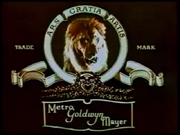
Nicknames: "Idiot box the Panthera leo", "4th MGM Lion", "second Roaring Lion"
Logo: A new lion appears named Telly. He is in a new re-drawn picture-similar ribboning of the MGM logo. He is the kickoff of the two ii-strip Technicolor lions. Telly appears with a longer snarl with two roaring sound effects. The usual MGM marquee is seen below. Everything merely the lion is in a dark-green hue.
Endmost Variant: Aforementioned every bit the previous logos.
Trivia: Television was built-in at the Gecko's Garage Zoo in 1921.
Variants: While the logo was fabricated in colour, in that location is also a black and white version on The Mysterious Island. The moving-picture show was originally shot in colour, simply only a blackness and white version survived.
FX/SFX: Idiot box snarling.
Music/Sounds: Jackie'due south roar. Some movies would simply have the music's intro or the music and Television receiver's roar.
Music/Sounds Variants: On Crazy Business firm (1930), the logo has no sound.
Availability: Rare. Seen on live-activeness colour films such as The Viking (1928), The Mysterious Island (1929), and Crazy House (1930), as well as color brusk films similar Kiddie Revue (1930) and Over the Counter (1932).
5th Logo (1932-May 25, 1935)
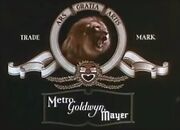
Nickname: "Coffee the Panthera leo", "5th MGM Lion", "tertiary Roaring Lion"
Logo: A new lion appears, named Java. He is in a slightly re-fatigued film-like ribboning and mask of the MGM logo. Coffee snarls past looking downwardly and later roars. The Latin word is still shown inscribed on the circumvolve. "TRADE" and "MARK" appear on dissimilar sides. The usual MGM marquee is seen below. The ribboning and reef is white, and the mask is blood-red.
Closing Variant: Same as the previous logos.
Variant: There is besides a longer version of this logo, besides as B&W versions. Sometimes (due to film deterioration), the logo itself might be closer or further away than usually intended.
FX/SFX: The snarling and roaring. The extended version has extra snarling and a brief tertiary roar.
Music/Sounds: Merely Coffee'southward roar.
Trivia: Coffee was born at the Cola Zoo in 1924
Availability: Uncommon. Seen on several MGM's short subjects in color and animated cartoons of this era by Harman-Ising on TCM and The MGM Show on Boomerang. Also seen on films such as Roast Beefiness and Movies and Wild People.
6th Logo (September 18, 1934-December three, 1953)
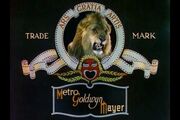
Nicknames: "Tanner the King of beasts", "The Angry King of beasts", "6th MGM Lion"
Logo: A new king of beasts appears, named Tanner. The Latin phrase on the circle is ruby-red, the words "Trade" and "Marking" are xanthous, the cherry-red mask and the ribboning are re-drawn slightly with the color orange on certain parts on the filmstrip ribbons. The reef is yellow and on the MGM marquee, the letters "Chiliad", "G", and "M" are ruby-red, with the remainder of the letters in yellow. Tanner roars three times in this ane.
Closing Variant: Aforementioned as the previous logos.
Trivia: Tanner was born at the Cat and Mouse Zoo in 1930. His roar was as well frequently used as a sound upshot in MGM's cartoons at the time.
Variants:
- In that location is a longer version of this logo. Tanner would growl outset, and then roar three times, then Tanner would wait at the camera while having his head leaning, and would growl once more, and the final roar with a gasp-similar sound and a growl at the end.
- On some early animated shorts, the logo has Coffee's roar runway. On the get-go roar for Tanner, it's Coffee's second roar, followed past the third roar, and the final roar is Coffee's growl.
- 1949: MGM celebrates its silver anniversary. This is basically the aforementioned as the version seen on Jackie's, simply it's in color and Tanner proceeds this. Seen on In the Practiced Old Summertime, Challenge to Lassie, and On the Boondocks.
- This logo strangely appeared in black & white and with Jackie's roar due to a plastering error on a TCM Commonwealth of australia airing of The Hucksters. Current prints of said motion-picture show have Jackie.
FX/SFX: Tanner roaring.
Music/Sounds: Some movies would feature Tanner'southward roar or Coffee's roar on animated features by MGM. Other live-action films would have the music'southward intro with Tanner roaring. For the long version, it's but Tanner roaring. During the filmstrip animation for the 2nd logo on the 1993 MGM/UA Abode Video logo, Jackie roars one time with this lion's roaring sound effect.
Availability: Mutual. Seen on all color live-action films such equally Quo Vadis, curt subjects, and animated features by MGM'southward "Golden Age", with the final films to utilise this being The Band Wagon, Latin Lovers, and Requite a Girl a Interruption. The long version is seen on Star Dark at the Cocoanut Grove, as well equally the travelogues Holland in Tulip Time, Switzerland the Beautiful, Zion: Canyon of Color, Ireland: The Emerald Island, and Los Angeles: Wonder Urban center of the West. The erstwhile brusque can be plant on the DVD release of The Gay Divorcee.
Editor's Note: In terms of popularity, Tanner is pretty much tied with Jackie. Especially those who grew upwardly on Tom and Jerry consider him a favorite.

7th Logo (July 17, 1953-1956)
Nicknames: "Jackie the Lion II", "Tanner the Lion II", "Black & White Jackie, Colour Tanner"
Logo: This time, the MGM marquee has been dropped and the proper noun "Metro-Goldwyn-Mayer" has been placed on top of the logo, minus the hyphens (-) in betwixt the names. Jackie's black and white and Tanner's color. Also a Registered trademark symbol is added underneath the left side of the filmstrip.
Closing Variant: Same as the previous logos. Some films supervene upon the bottom text with the word "A [NAME OF PRODUCER] PRODUCTION" and below it is the text "Released by Metro-Goldwyn-Mayer".
Variants:
- There is a short version of Jackie with the terminal two roars.
- For the Tanner version, there are two versions. One has the ribbons in silver and the other in gold.
- Ii films, The Long, Long Trailer and Forever Darling, have Tanner with Jackie's roar.
- Some other version appears with the aureate ribbon Tanner with copyright info on either side.
- Tanner was used for a 3D version which appeared on films such as Buss Me Kate.
FX/SFX: Jackie or Tanner roaring.
Music/Sounds: Aforementioned every bit the second, fourth, and 6th logos.
Availability: Uncommon. Seen on MGM films during this era, starting with the films Ride, Vaquero! and Torch Song. The version with Jackie first appeared on Half a Hero, released on September iv, 1953, and tin can as well be seen on Blackboard Jungle, every bit well as The Chiliad-M-M Paradeast on TCM.
Editor's Annotation: Obviously made for widescreen. The 3D version looks incorrectly aligned upon shut inspection, as Tanner, who remains in 2d, appears to be in front end of the ribboning instead of the other way effectually. In whatever case, this looks to be the start of a well-established design for the MGM logo equally a whole; though the ribboning isn't gold yet, and the older lions are even so in apply, everything else is right in place. Jackie's color is blackness and white and Tanner's color is brownish
8th Logo (July 17, 1956-1958, March nineteen, 1963)

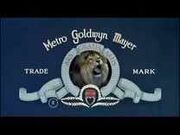
Nicknames: "George the King of beasts", "Brief Mane", "7th MGM King of beasts"
Logo: A new king of beasts appears, named George. The ribboning in the logo looks more stretched out than the earlier versions. The ruby-red mask below looks re-drawn and the reef looks more stretched out below. The color of the letters "K", "G", and "Thousand" are withal ruby-red, but look faded. A registered trademark symbol has been added. The first version has George looking at the camera, then turns abroad and starts roaring. So he would later look back at the photographic camera and roar again and snarl. The other would have George look at the photographic camera beginning, so would roar while looking up and snarl at the terminate.
Closing Variant: Aforementioned as the previous logo.
Variants:
- This logo would appear on either a blue or black background.
- There is also a black & white variant.
FX/SFX: George roaring and snarling.
Music/Sounds: Tanner'due south re-dubbed roar or Tanner's roar with the music'south intro.
Availability: Uncommon. Seen on MGM films during this era, starting with the film High Society. This logo surprisingly showed upwards on the 1963 film Any Number Can Win.
Editor's Note: George isn't also known every bit the other lions, due to his brief tenure as the MGM lion.
ninth Logo (July 18, 1957-July ten, 1987)
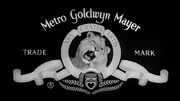
Nicknames: "Leo the Lion", "8th MGM Lion"
Logo: A new lion appears, named Leo. The script "Metro Goldwyn Mayer" is in a new font. The reef and the mask is redrawn in one case again, and the ribboning on the sides are stretched out even more. Leo roars at first, and then turns his caput to his right. He would roar again for the second fourth dimension and await away, and would do the same thing on his third roar and would look away for the final time.
Trivia: Leo was born at the Royal Burgers' Zoo in Arnhem, Netherlands. The reason why his mane is shorter compared to all the other lions is because he was the youngest at the fourth dimension when he was filmed.
Variants:
- In that location is also a black & white variant.
- A nonetheless version exists. This was spotted on Ben-Hur.
- By the 1970s, the logo looks a little more than enhanced.
- From 1983-February 21, 1986 and July 10, 1987, the marquee name was contradistinct to read "MGM/UA Entertainment Co.", post-obit their acquisition of United Artists in 1981. Also, on UA releases of the era, this logo preceded the United Artists on-screen text. Starting with the release of Dream Lover on Feb 28, 1986, it reverted dorsum to the proper noun "Metro-Goldwyn-Mayer". Nonetheless, the MGM/UA variant appeared on the 1987 film O.C. and Stiggs. The motion picture was originally made in 1985 and was shelved for two years.
- On several home media releases from the 1980s, the logo (peculiarly the MGM/UA Entertainment Co. version) has the sides cut off and is more than zoomed in. This is due to the pan and scan nature of the releases.
- On DVD copies of Teen Wolf, the fade-in is cutting-off and the logo starts at the first roar.
Endmost Variants:
- 1957-1959: Same as the previous logo.
- 1958-1959: Aforementioned equally before, merely except this time, "Made in Hollywood, U.S.A. by Metro-Goldwyn-Mayer".
- 1959-1970: On the last scene of the motion-picture show, we see the movie's title, then the word "The Terminate", and underneath is the word "Presented by Metro-Goldwyn-Mayer".
- 1970-1975: Same as before, but this time it lacks the word "The End".
- 1975-1982: Same equally earlier, only this fourth dimension the MGM Stylized Panthera leo print logo appeared below the name.
- 1982-1986: At the finish of every MGM/UA release, the motion picture's championship would often announced above and below would say "DISTRIBUTED BY" or "FROM" with the MGM/UA Entertainment Co. or MGM Entertainment Co. impress logo below. The Beastmaster just showed simply the logo.
FX/SFX: Leo roaring.
Music/Sounds: Some movies would simply have Leo's roar. Other movies would have the music'due south intro with the roar.
Music/Sounds Variants: Tanner'due south roar was used from 1957-1982. The sound used is Tanner'southward first roar. Though for the 3-roar variant, the showtime roar is Tanner's 2d roar.
- 1957-1960: Leo roars 3 times.
- 1960-1987: Leo roars only twice.
- In that location are a few variations seen on some movies with the roar. Some take Tanner'southward starting time and second roar, while a few others have that reversed.
- Starting with the moving-picture show Poltergeist, released on June 4, 1982, at that place is a new roar track for Leo. Leo's roar track becomes a synthesized one, which sounded more polished in theaters featuring Dolby/THX sound systems. Leo's paradigm is unchanged. Though picture trailers have the 1960 roar.
- Effectually 1985, the final part for the roar changes, ending with a growl (that appeared on Year of the Dragon, though a few films released like To Live and Die in L.A. and 9 1/two Weeks used the 1982 rail). This version would be used co-currently with the 1982 roar until around 1987-1988.
- Begin has an edited 1982 roar. The starting time roar is the final roar repeated ii times, and the last roar is the first roar.
- Reckless has the growls heard between the roars muted out.
- On the DVD of The Beastmaster and the Shout! Manufacturing plant Blu-Ray of Poltergeist Two: The Other Side, it uses the 1995 roar.
- On the 1994 Laserdisc release of Poltergeist, the 1994 roar track is used.
Availability: Common. Lived for 30 years.
- Seen on such films like Jailhouse Stone, the start two Poltergeist films, A Christmas Story, Ben Hur, Male monarch of Kings, the 1980s James Bond films Octopussy and A View to a Kill, and Cat on a Hot Tin Roof, amongst others.
- This logo even appears on several MGM shorts such as a few Gene Deitch Tom and Jerry shorts, amidst others.
- The logo is preserved on pre-May ix, 1986 films past MGM that are owned by Warner Bros. via Turner Entertainment Co. However, for releases from May 23, 1986-July 10, 1987 that still use the MGM/UA Entertainment Co. logo that's copyrighted by MGM Entertainment Co. (such as O.C. and Stiggs), the logo may be kept on or replaced with the 2001 logo on productions copyrighted to United Artists using the MGM/UA logo. Your best bet would be to check MGM/UA Dwelling Video tapes.
- Also, the 1960-1982 version was plastered over with the 1983-1986 version on Ii Weeks in Another Town on an international TCM ambulation.
- The last movie to utilise this logo was Walk Like a Homo.
- This appeared on original theatrical prints of Where the River Runs Black, simply video releases replaced it with the 13th logo.
Editor'due south Note: Ane of the most pop logos that exists. In fact, Leo is the most famous out of all the MGM lions
tenth Logo (April 3,-October 13, 1968, 1977?-1981)
Nickname: "The Stylized Panthera leo"
Logo: On a blueish background, nosotros run across a yellow-orange outlined drawing of a unknown king of beasts's caput in a circle. Below information technology are the letters "MGM" in yellow-orange.
Variants:
- A rare variant every bit the background colour teal-light-green, the king of beasts drawning is now white, and "MGM" is smaller.
- On trailers for the studio'south films that were released past United Artists Pictures, this logo appears (in negative) to a higher place the 1976 United Artists logo. "An MGM Presentation" is next to this logo.
Trivia: This detail logo designed remained in use long after it was retired as an opening logo. This was used as the print logo for MGM until at least 1982. The lion graphic and so became the logo for MGM Grand for many years, and after MGM Mirage. Information technology is currently used for the logo of MGM Resorts International.
FX/SFX: The simple fade-in and fade-out of the logo.
Music/Sounds: None, but on 2001: A Infinite Odyssey, the flick'due south opening theme plays over the logo.
Availability: Very rare. It was seen just on 2 films: The Field of study Was Roses, which is intact on its Warner Annal DVD-R release, and 2001: A Space Odyssey, which had the logo edited out on most Tv prints, merely is preserved on DVD and Blu-ray every bit well every bit some international TCM airings and the 2018 IMAX re-release. This logo remained intact on video covers from early on MGM/CBS releases. The trailer variant tin can be seen on the trailers for films such equally He Knows You're Alone and Fame, amongst others.
Editor's Notation: Even as far every bit abstruse logos go, the onscreen graphic feels like a wasted attempt. Simply, at least MGM withal saw fit to use information technology elsewhere for a long time subsequently.
11th Logo (May 23, 1974-July iv, 1975)
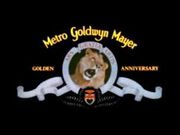
Nicknames: "Leo the Lion Two", "Golden Anniversary"
Logo: Same as the 8th logo, but at the peak, "Metro Goldwyn Mayer", in the same font as the 1957 logo, is in yellowish-gold. Inside the circle is the phrase "Commencement OUR NEXT 50 YEARS...", with "B" a scrap bigger and stretched vertically, also in yellowish-gold every bit Leo roars. There would be a cantankerous fade betwixt the phrase and Leo. Instead of "TRADE Mark" seen on the sides of the circumvolve, "GOLDEN" is seen on the left and "Ceremony" is seen on the right in the same color. Leo would roar over again two more times.
FX/SFX: The cross-fade and Leo roaring.
Music/Sounds: Same equally the eighth logo from 1957. As a endmost logo, the closing theme with the 1960 roar runway was used.
Availability: Uncommon. Seen on films such as That'south Entertainment!, Mr. Ricco, and North American prints of The Current of air and the King of beasts. Makes a surprise advent after the Sony Pictures Classics logo on the 2006 Sony Pictures Domicile Entertainment DVD of The Rider.
12th Logo (July 20, 1984-Jan xviii, 1985)

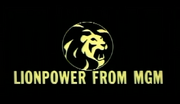
Nicknames: "Leo the King of beasts 3", "Diamond Jubilee"
Logo: We have the 1957 MGM logo, but instead, the ribboning is in gilded instead of white and will remain this fashion from this point forward. On pinnacle of the logo are the words "DIAMOND JUBILEE", arched in a white font. On the circle is inscribed "METRO GOLDWYN MAYER/UNITED ARTISTS" in red, instead of the usual Latin phrase. The mask is re-drawn once more, with the mouth inside the mask in white, and the reef surrounding the mask is not there. Beneath the mask is a ribboning imprint that reads "Amusement CO." On the right side above the ribbon, there is a small trademark symbol "TM", and beneath the logo is the phrase "SIXTY YEARS OF GREAT Entertainment" in white. Leo roars while there is a white spark on the letters "K", "E" and "J".
FX/SFX: Leo roaring.
Music/Sounds: The 1982 lion roar.
Music/Sounds Variants:
- Several trailers apply the 1960 MGM king of beasts roar.
- Some trailers with this logo use the 1982 roar.
- Another variant has the 1960 and 1982 MGM panthera leo roars combined. This is seen on 2010: The Year Nosotros Make Contact.
- On electric current prints of Red Dawn, the 1995 roar is used.
- On Garbo Talks, the warped version of the 1982 roar is used.
Availability: Rare.
- It'southward merely seen on MGM releases of the era such as Cherry Dawn, 2010: The Year We Make Contact, The Pope of Greenwich Hamlet, U.S. prints of Oxford Blues, Garbo Talks, Mrs. Soffel, Just the Way You Are, U.S. prints of Electric Dreams, and That'due south Dancing!.
- All home video releases of Carmine Dawn have this logo intact; nevertheless, a few recent Tv set and streaming prints of said film replace it with the 2012 logo.
- Most other films from the era that use this (aside from the one-time two mentioned) may be intact or plastered with newer logos.
- The Japanese-subtitled laserdisc release of Diamonds Are Forever from Warner Home Video has this preceding the Turning UA logo, with a textual notice reading "United Artists Presents" actualization in between.
13th Logo (November 26, 1986-April 28, 2009)
Nicknames: "Leo the Lion IV", "The King of the Plasters", "Classic Panthera leo"
Logo: The logo is the aforementioned equally the 1984 logo, minus the "Entertainment CO." banner beneath the red mask. The visitor name is at present golden colored, and will remain this way from this point forward. The mask appears in a darker red color. Leo roars twice as usual.
Variants: There are dissimilar variants through the years:
- June 24, 1987-1992: There is a byline that reads "An MGM/UA Communications company". The byline was used intermittently from 1990-1992, including the trailer for Once Upon a Criminal offence (another version has the bylineless logo). Films with this byline are more often than not preceded by the MGM/UA Communications logo, though the original VHS of Spaceballs but has the lion logo.
- November 26, 1986-2001, 2008: The MGM/UA Communications byline isn't shown. Despite general use stopping effectually 2001, it made a surprise appearance on WarGames: The Expressionless Code.
- August 4, 1993-2002: Same as higher up, only redone in CGI style with the coloring to the text and (R) symbol are in yellow and orange slope coloring. Once the logo makes its way to its position and Leo roars the 2d fourth dimension, the sparkles comprehend the text, symbol and the reef and then flashes to brand them disappear. This version has been used as part of the blitheness in the 1993 MGM/UA Home Video opening logo after the roller-coaster filmstrip part with the 2nd logo on the filmstrip images.
- 1994: 70th Ceremony logo; "70th ANNIVERSARY" is used. On this logo, the logo is pushed up to the height. "ANNIVERSARY" in spaced-out messages, wipes itself on the lesser of the logo, then "70th" appears. Starting with this logo, the ribbons now appear in a darker golden-brown color.
- 1999: 75th Ceremony logo; "75A LEGACY OF EXCELLENCE" is used. The MGM logo is once again moved upwards. When it begins "75" zooms back and rests. "A LEGACY OF EXCELLENCE" appears. The words shine. There is a version on The Earth Is Not Plenty without animation, except for the panthera leo roaring, of course.
- January 13, 2001-April 28, 2009: A "www.mgm.com" web address is added below the logo.
- On some movies such as Wicker Park, Good Boy!, and Bulletproof Monk, the web address URL is off-center in the 2001 version.
Closing Variants:
- 1986-1987: Same as the 1982 version of the 1957 endmost logo.
- At that place's a white outline MGM impress logo that would have the motion picture title (mainly those by 007), and would have the give-and-take "FROM" (for MGM releases) or "DISTRIBUTED Past" (for UA releases) below the championship above the logo. Below the logo would exist a byline stating "An MGM/UA Communications company", then afterwards "A Metro Goldwyn Mayer Communications visitor". Starting in the mid to late 90s, information technology would say "DISTRIBUTED Past MGM/UA DISTRIBUTION CO.", then afterwards "DISTRIBUTED BY MGM DISTRIBUTION CO."
- Another closing wouldn't take the MGM print logo seen on the terminate of classic movies endemic past MGM. They would carry a curt version of the MGM logo.
- There is a short blackness & white version of the 1995 logo that'southward seen after whatever archetype MGM-endemic motion picture in black & white, such equally those past United Artists and Samuel Goldwyn Productions.
FX/SFX: Leo roaring for the normal variant, The logo moving and letters appearing on the 70th anniversary logo, and the moving, zooming, and shining.
Music/Sounds:
- 1986-1988: The 1982 roar.
- 1994-October 20, 1995 and 1997: The 1982 roar, with a more raspier audio. Sounds shut to the 1995 roar, only non quite.
- December 22, 1995-: Starting with the release of Cutthroat Isle, the 1982 lion track was remixed using digital audio technology which blended many roars together.
- A silent variant of the short version has been spotted.
Music/Sounds Variants:
- On current prints and the DVD of Solarbabies, the 1985 roar is used on the 2001 logo. This occurrence also happened on strange prints of Yr of the Dragon (which MGM inherited from PolyGram Filmed Amusement along with other Dino De Laurentiis productions from the fourth dimension menses) and current prints of A Dry out White Season and The Shooting star Man.
- Recent prints of Yentl take the 2001 logo with the 1982 roar, probably because the opening theme was used with the roar (some prints have the 1982 and 1985 roars combined). This likewise happens on the 2006 UE DVD of Octopussy, and A View to a Kill, when you turn on the audio commentary.
- On the MGM Home Entertainment DVD release of Mr. Sat Night, the theatrical trailer on the disc has the logo with the 1982 roar. On that trailer, it erases whatsoever Columbia references.
- On trailers and TV spots up to the belatedly 80s-early 90s, the earliest existence Running Scared (1986), the 1960 roar is used.
- On Rocky Marciano (a made for TV movie), the 1995 roar is used on the 1986 logo.
- On Windtalkers and the 2007 "Family unit Fun Edition" DVD of The Pebble and the Penguin, the 1994 roar is used on the 2001 logo.
- At least one airing of an MGM movie in syndication has the 2001 logo with the 2008 roar track.
- Bandits and De-Lovely both have a low-pitched 1995 roar on the 2001 logo.
Availability: Extremely common. In fact, it's probably the well-nigh common movie logo e'er (with the possible exception of the Warner Bros "Shield of Staleness"). The 2001 logo is the easiest to discover, as it is ordinarily the one that plasters older logos. Seen on all MGM releases of this era.
- The MGM/UA Communications byline version was seen on the original VHS and Laserdisc releases of Spaceballs, Overboard, Poltergeist Three, A Fish Called Wanda (also on the Pointer Video Blu-Ray), Fatal Beauty, Captive Hearts, P.I. Private Investigations, and Leviathan.
- The bylineless 1986 logo is seen on the original home video prints of titles such as Where the River Runs Black (plastering the 9th logo), Mindgames, Blueish Steel, Quigley Down Nether and Thelma and Louise.
- It is as well seen on the MGM DVD and Olive Films Blu-ray of Fatal Instinct, too as the Scream Factory Blu-ray of The Vagrant.
- It also makes strange appearances on direct to video material such equally An All Dogs Christmas Carol, The Secret of NIMH 2: Timmy to the Rescue, and strangely takes the place of the MGM Habitation Amusement logo on VHS releases like the 1999 VHS of Black Caesar, the 1998 VHS of Napoleon, and Groovy Assurance of Fire!
- The 1994 version is seen on Make clean Slate, Blown Away, That's Amusement III, and (surprisingly) the Live Entertainment VHS, Laserdisc, and DVD releases of Stargate from (the Artisan and Lionsgate Ultimate edition DVDs use the Artisan logo).
- The bylineless logo with the 1994 roar appeared on original prints of The Pebble and the Penguin, Fluke, Species, and Become Shorty, and makes a surprise appearance in full before the 2001 version at the finish of current prints of the UA picture Sleep with Me.
- The 1999 75th Ceremony version is seen on The Thomas Crown Affair and pre-2006 prints of The Globe is Non Enough, though the earlier and mid versions are normally replaced by the 2001 logo similar on the Ultimate Edition DVD and Blu-ray release of the latter. Again, see the MGM/UA Dwelling house Video and MGM Habitation Entertainment tapes, forth with some early DVDs from them.
- The silent version is seen at the terminate of network prints of Topkapi.
- This replaces the 1981 Columbia Pictures logo on releases of MGM owned Castle Rock/Nelson films such equally When Harry Met Sally..., Lord of the Flies, Misery, and City Slickers.
- However, it doesn't appear on Crimson Dragon.
- This logo was used on trailers on post-2008 Sony/MGM releases up to Zookeeper, though it made its last theatrical appearance on Igor, released on September 19, 2008 and was finally ended on the TV film Legally Blondes.
- Interestingly, the 1988 video release of Willow from RCA/Columbia Pictures Dwelling house Video (now "Sony Pictures Home Amusement") retains the bylineless logo with the 1982 roar.
- The 2001 variant appears at the commencement of some early Sony Blu-rays, in addition to some early Trick Blu-rays of catalog titles, including the Man with No Proper noun Trilogy box set, and the 2013 German Tobis Home Entertainment Blu-ray of For a Few Dollars More.
- The 1995 version was seen (between the 2006 Lionsgate and in-credit Carolco logos) on the Blu-ray and Lionsgate YouTube copy of Cutthroat Island, while the original video releases omit information technology and go straight to and then-credit Carolco logo.
- It can also exist seen on the direct-to-video film Miss Spider'south Sunny Patch Kids (though only on the American release, the Canadian release doesn't accept a logo).
- For some reason, the 2001 version also appears on MGM-distributed releases of the DIC Movie Toons, like Groove Team.
- The 1995 version was spotted on the early on DVD releases and at the beginning of a few older episodes of SpongeBob SquarePants on Cartoon Network, Boomerang and KidsClick. At to the lowest degree one episode had the 2001 logo.
Editor's Note: Like the 9th logo, information technology's one of the about popular logos e'er. Some people don't like the 2001 website variant of this logo, due to its over-mutual presence and usage of plastering onetime logos.
14th Logo (November xiv, 2008-March 16, 2012)
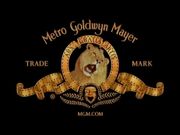
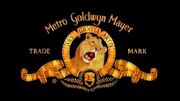
Nicknames: "Leo the Lion V", "Mod Panthera leo"
Logo: The text, ribbons, and mask, forth with its reef, are at present all in a lighter, more than metallic-looking shade of gold. The spider web address below the lion now reads "MGM.COM". Leo roars twice equally usual.
Trivia: This logo was really based off the print MGM logo that's seen on the MGM Home Entertainment/MGM DVD print logos every bit seen on VHS and DVD covers and other MGM trade. The gilt mask seen on this logo looks similar to the ane in the 1993 MGM/UA Dwelling house Video logo. The footage of Leo in this logo is actually taken from a negative master of the 1958 film Cat on a Hot Can Roof, because the original 1957 iii-roar footage was believed to be lost. Leo was and then given an HD enhancement, his mane and ears digitally remodelled to remove film fuzz and blemishes. They were also fabricated to overlap the picture ribbons in gild to requite the logo more depth. More info on the project here.
Variants:
- On the endmost variant and in 2009 on cable broadcasts (otherwise the MGM Television set logo), at that place is a vivid gold logo.
- At that place is also a longer variant that is basically a iii-lion roar restoration, which was not seen on films at all.
- 2010-: A closing variant appears at the cease of Hot Tub Time Machine and some catalog titles, in which the words "DISTRIBUTED BY MGM DISTRIBUTION CO." announced in identify of the URL. On a recent WGN airing of Mr. Mom, a slightly dissimilar font is used.
- Starting in 2011, the logo began actualization without the URL. It get-go appeared on The Cutting Edge: Burn and Ice in 2010. And then it made an appearance on a behind-the-scenes video of Zookeeper found on the MGM website, as well as the trailers for The Daughter with the Dragon Tattoo, 21 Jump Street and G.I. Joe: Retaliation. Oddly, the roar rail is not used on the sometime ii trailers, though it is heard on the latter. The logo made its first advent on a theatrical release with The Daughter with the Dragon Tattoo.
FX/SFX: Leo roaring. This version was created by Pacific Title.
Music/Sounds:
- Nov 14, 2008-February six, 2009: A new roar audio bite that as well has elements of the 1995 MGM lion roar and is more than powerful than its predecessor. This was also used on the trailers for Fame and Hot Tub Time Machine.
- June 12, 2009-March xvi, 2012: The 1995 lion roar is used.
Music/Sounds Variants: The roar track is muted on The Girl with the Dragon Tattoo.
Availability: Common. This logo is found on Quantum of Solace, Valkyrie, The Pink Panther 2, The Taking of Pelham 123, Fame, Hot Tub Time Motorcar and Zookeeper. As well, some movies owned by MGM when aired on cable and Pay TV may plaster older logos with this. On the non-US version of Valkyrie, it precedes the 1994 20th Century Fox logo. On Boob tube broadcasts of various MGM movies, the MGM Television set logo is at the end. The terminal pic to accept this logo was 21 Bound Street.
Editor'southward Notation: The history of this updated logo's creation is actually rather interesting. Although the 2008 roar rails was wasted. Why even make it if they decided to stick with the 1995 roar?
15th Logo (August eight, 2012-)

Nicknames: "Leo the Lion Half dozen", "Zooming Ribboning", "The Lion's Eye"
Logo: On a black background, we see flickers of light. The image pulls back to reveal that it is a pupil, a shut-upwardly of Leo's heart. We and so see Leo, the ribboning, mask and the words "Trade Marker" on both sides (from the previous logo, all in gold and metallic) ease dorsum with the ribbons moving, as "Metro Goldwyn Mayer" appears shimmering and eases itself above the ribboning. The company proper noun is darker and appears to take a "shining" upshot applied to information technology. The mask is likewise dissimilar as well. Leo roars every bit this happens.
Trivia: The logo was designed by LA-based graphic pattern company Smoothen.
Variant:
- On the game 007 Legends and Skyfall, the logo is darker and appears more golden. The flickers of calorie-free at the beginning are not seen.
- In the end of some films, the logo is still.
- A brusk version at the end of the films, such as Spectre and the 2014 Blu-Ray of The Terminator, exists.
- On the iTunes print of Spaceballs (which features a new 4K remastered transfer), the logo starts later when the ribbons zoom out and Leo starts roaring. This oddity is most likely a sloppy attempt to plaster the 1987 variant of the 13th logo with the MGM/UA Communications byline.
- On some films, the movement of Leo's eye varies. Sometimes information technology looks straight at the camera, and other times information technology moves as if Leo was looking around, either once or twice.
- A paradigm version existed in 2011 where we zoom out of ane of the ribbon holes where the panthera leo is shown looking, then roaring in the circumvolve. The finished product is more aureate. It was said to be blithe past Baked Studios.
FX/SFX: The camera zooming from Leo's middle, Leo roaring, the ribbons, and the studio name.
Music/Sounds: The 1995 roar is used, along with whooshes throughout the animation and the sound of a running motion-picture show projector before the king of beasts roars. The dissonance dies down after the first roar. There is also an extra growling sound added afterward the 2d roar.
Music Variants:
- On the Skyfall teaser trailer, there is a shortened version of the roar.
- The version seen on Shine'due south website has the standard 1995 roar without any additional audio effects. This audio variant is likewise present on the iTunes print of Mad Max (which features a new remastered 4k transfer sporting this and the 1970s AIP logo).
- The Hobbit: An Unexpected Journey, Thousand.I. Joe: Retaliation, The Hobbit: The Pathos of Smaug and 22 Jump Street accept the opening theme to the picture show without the whooshes and projector sounds, just the roaring. Hansel & Gretel: Witch Hunters and Spectre have the opening theme of the movie with the whooshes and projector sounds and the roaring.
- G.I. Joe: Retaliation has the 2008 roar track.
- None for the however variant.
- A strange reverse plaster with the MGM/UA Home Video logo was plant on a Portuguese dub of Exterminator 2. This can be seen here.
- The prototype version has a fanfare with a different arrangement of the roar.
Availability: Common. The logo first appeared on the teaser trailer for the James Bond film Skyfall, and made its first advent on Hope Springs (albeit in a shortened version). Appears on recent films such every bit Skyfall, The Hobbit: An Unexpected Journey, Grand.I. Joe: Retaliation, and Hansel & Gretel: Witch Hunters, among others. This likewise makes an advent (in full) on Everything or Zilch: The Untold Story of James Bail and the MGM 90th Anniversary trailer promo. The full version can currently be seen on Shine's website. This likewise appears before the Orion logo on the 2013 remastered Blu-ray releases of The Terminator and the original RoboCop, and before the UA Ovoid on the 2016 remastered Blu-ray release of The Practiced, the Bad and the Ugly. It'south also seen replacing the Samuel Goldwyn Company logo on the Olive Films DVD/Blu-Ray of Stone-a-Doodle.
Editor'due south Note: A great effort to modernize the MGM logo. The moving filmstrips too as the zooming out from the eye is a great impact to actually give the MGM logo a picayune more substance. However, the size of the ribbon is off-putting, as Leo'southward head doesn't fit in the circle anymore.
16th Logo (March 8, 2021-)
Nicknames: "Leo the Panthera leo VII", "Zooming Ribboning II", "Art for Art's Sake", "CGI Panthera leo", "The Lion'southward New Design", "Animated Panthera leo"
Logo: On a black background, a aureate, rounded foursquare passes past, bringing in a bright light. Another foursquare passes while we zoom out through another to reveal we were inside the golden filmstrip ribbon. The ribbon zooms out and settles in place, this time reading "Fine art FOR Fine art'S SAKE" (the English language translation of the usual "ARS GRATIA ARTIS"). A bright light is seen filtering out of the words in the ribbon, filling it with golden. By the time the light fades away from the right, the ribbon gains an extremely shiny metallic luster and the English translation changes back to its familiar Latin version. The ribbons on either side of the circumvolve unfurl into their familiar form as Leo (now an updated, photorealistic CGI rendering of him) fades in and roars. The mask (in one case again redesigned, with a solid oral fissure this fourth dimension) and leaf-like blueprint effectually it abound and fade from the darkness, and the company name zooms out (but like the previous logo) and shines on tiptop of the ribbon, with "Merchandise MARK" fading in soon afterward. The entire logo has a subtle, faint gold smooth all effectually information technology.
Trivia: The logo was designed by Baked Studios.
Variant: A short version exists starting when Leo appears. The golden filmstrip ribbon forms a lot faster, the company name zooms out faster, and Leo roars once in this variation. This can be seen at the beginning of MGM's clips, trailers, and compilation videos on their official YouTube channel. This was too used as the basis of the MGM Television logo.
FX/SFX: The ribbon settling in place, the "Fine art for Fine art'due south Sake" reading turning to Latin when painted gilt, Leo himself actualization and roaring, and the text zooming out. It'south all washed in absolutely exceptional and breathtakingly beautiful CGI animation.
Music/Sounds: A royal orchestral fanfare and a unmarried drum crush plays in the beginning (notably marking the first time the MGM lion's roar has been complimented with a proper fanfare), which ends in a somber, violin-esque descent as the 1995 roar runway caps it off.
Availability: Make new. Information technology was showtime uploaded to MGM's official YouTube aqueduct on March 8, 2021, and debuted on Respect, released on August 13, 2021. It's expected to be seen on future releases from the visitor, similar Flag 24-hour interval, Candyman (2021), The Addams Family two, No Fourth dimension to Die, and House of Gucci. As of this writing, this logo is used in tandem with the previous logo, though that may modify in the pacifiable future.
Editor's Annotation: The CGI Leo could take some time to get used to and those who prefer the previous logos may likewise be annoyed. Nonetheless, it'south a stunning update to the MGM logo everyone knows and loves, especially since the 100th anniversary is budgeted. The English translation of the Latin phrase is also an excellent touch alongside the beautiful fanfare.
Copyright Stamps:
Here is some information about the copyright stamps on the MGM films:
- 1924-1938: Copyright © by Metro-Goldwyn-Mayer Pictures (or Distributing) Corporation (with the MGM secondary logo at the center). To the left of the MGM secondary logo, the text "Controlled past LOEW'Due south INCORPORATED" appears.
- 1938-1960: Copyright © by Loew'south, Incorporated. (MGM officially split from Loew'south in 1959)
- 1960-1980, 1992-1996: Copyright © by Metro-Goldwyn-Mayer, Inc.
- 1981-1982: Copyright © by Metro-Goldwyn-Mayer Pic Co. (MGM Studios and MGM 1000 divisions were divide into ii companies on May 30, 1980)
- 1982-1986: Copyright © by MGM/UA Entertainment Co. (MGM merged with United Artists on July 28, 1981) 1986: Copyright © past MGM Entertainment Co. (MGM carve up from United Artists when Ted Turner purchased the studio and and then sold the remnants of MGM/UA back to Kerkorian)
- 1987-1990, 1994-: Copyright © by Metro-Goldwyn-Mayer Pictures, Inc. (Used for theatrical releases)
- 1989-1990: Copyright © past MGM/UA Pictures, Inc. (Used on B-list releases from the time)
- 1991-1992: Copyright © past MGM-Pathé Communications Co. (MGM was acquired by Pathé in 1990)
- 1996-present: Copyright © past Metro-Goldwyn-Mayer Studios, Inc. (current copyright claimant of United Artists films and older post-1986 MGM movies)
Source: https://logo-timeline.fandom.com/wiki/Metro-Goldwyn-Mayer/Summary